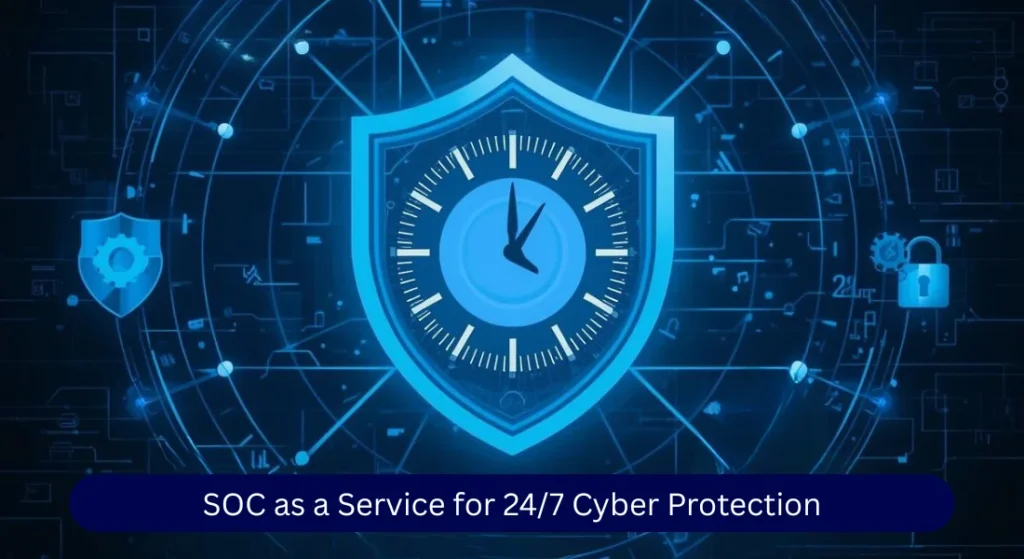When it comes to your cybersecurity and daily security functions of your business, a Security Operations Centre (SOC) is the central place for all these activities.
This is why a lot of companies are using SOC as a Service. It’s an intelligent system that combines AI-powered automation with skilled cybersecurity analysts. With this new model, even mid-sized businesses can get high-end SOC cybersecurity benefits. And they don’t even need to run their own operations centre.
And if you’re confused or wondering whether your company needs a SOC service, the answer is probably yes. Read on and you’ll find out why and how.
What Is SOC as a Service?
It’s important to know what SOC as a Service really means before going any further.
Security Operations Centre as a Service (SOC as a Service) is a managed security service that runs in the cloud and gives businesses the ability to monitor their systems all the time, find threats and respond to incidents. Companies can use specific providers that offer these services remotely instead of building and staffing their own SOC.
This method uses the latest security automation tools, AI analytics, and expert analysts to make sure that security events are found, analysed, and resolved quickly, no matter the time or day.
What Types of Threats Does a SOC Help Protect Against?
SOC as a Service plays an important part in finding and stopping different kinds of threats that modern businesses face. Before we list them, it’s important to note that these threats can come from both inside and outside the company, and they get more complex every day.
1. Malware and Ransomware Attacks
These are some of the most dangerous cyber threats. There are some techniques which help SOC cybersecurity teams find these viruses before they can spread. These techniques include behavior-based detection tools and sandboxing techniques.
2. Phishing and Social Engineering
SOC analysts can find suspicious patterns in network and email traffic and stop harmful links or domains from reaching employees. They do this by monitoring both.
3. Insider Threats
Insider threats can be intentional or unintentional. But irrespective of it, they can lead to big data leaks. SOC monitoring tools can help identify unexpected access patterns, misuse of privileges, or unexpected data transfers.
4. APTs or Advanced Persistent Threats
APTs are attacks that happen over a long period of time and are hard to see. They steal sensitive information. SOC cybersecurity teams use threat intelligence, behavioural analytics and endpoint detection to find and stop these kinds of campaigns.
5. Distributed Denial-of-Service (DDOS)
SOC monitoring platforms find sudden increases in network traffic that could be a sign of a DDoS attack. This lets them quickly stop the attack before systems go down.
How SOC as a Service Combines AI & Human Expertise
Modern SOCs use a hybrid defence model to stay one step ahead of cybercriminals. This means that AI-driven automation and human intelligence work together. This is how working together makes protection better:
1.AI for Speed and Growth
Artificial Intelligence processes huge amounts of security telemetry like logs, alerts and network traffic, in real time.
- Machine learning algorithms detect abnormalities and any user behaviour that seems suspicious.
- Automated correlation engines link alerts that are related to find multi-vector attacks faster.
- SOAR (Security Orchestration, Automation, and Response) platforms automate incident response tasks that happen over and over again. This reduces the time it takes to find and respond to an incident.
2.Human Analysts for Insight and Judgment
AI can find problems, but only humans can give them context, explain them and make decisions. Analysts look at alerts and verify if they are real. And then they take specific steps to stop them. They know how incidents affect business, connect the incidents, and improve detection rules so they can handle future problems better.
This combination of AI and people changes SOC as a Service from passive monitoring to active threat defence.
What are the Main Functions and Responsibilities of a SOC?
A Security Operations Centre (SOC), whether it’s in-house or provided as a service, does a number of coordinated tasks to make sure that everything is secure. Here is a general idea of what these functions usually involve.
1. Constant Monitoring
SOC cybersecurity teams keep an eye on network traffic, endpoint activity, and cloud environments around the clock to look for strange behaviour. This makes sure that threats are immediately visible on all digital assets.
2. Finding and Analysing Threats
The SOC finds, checks, and ranks threats using advanced analytics. To find hidden risks, data from multiple sources like firewalls, intrusion detection systems, and endpoints is compared.
3. Responding to an Incident
When a threat is confirmed, the SOC makes sure that containment and recovery efforts are coordinated. Automated response playbooks take care of everyday problems, and analysts look into more complicated cases that need more time and effort.
4. Vulnerability Management
Regular scans and assessments of vulnerabilities make sure that systems stay safe from known attacks. SOC teams often work with IT departments to decide which patches to put on first and how to prioritize them.
5. Combining Threat Intelligence
SOC cybersecurity teams use global intelligence feeds to keep up with new threats, attack campaigns, and indicators of compromise (IoCs). This helps them be prepared for attacks before they happen.
6. Support for Reporting and Compliance
Since SOC involves regular reporting, it helps businesses keep track of incident trends, response times, and compliance standards.
Benefits of SOC as a Service
Before you make a decision on whether you want the SOC model or not, it’s helpful to know what makes it so useful for modern businesses.
- 24/7 Proactive Monitoring: With continuous coverage, no threat can go undetected, even during the off-hours.
- Faster Detection and Response: Automation and AI makes it possible to analyse things in real time, and expert analysts make sure that the right actions are taken to fix the problem.
- Scalability: Companies can change the size of their SOC services based on how big they are and how much they are at risk.
- Cost Efficiency: You don’t have to pay for security infrastructure and specialised staff that you have to maintain.
- Access to Expertise: Use the skills of experienced analysts, forensic experts, and incident responders without having to hire them internally.
Next Steps
If you think your business needs stronger, 24/7 coverage, you might want to look into managed SOC solutions. A well-designed SOC can help you see what’s going on, respond quickly, and stay safe in the face of today’s changing threats.
What to Look For:
- Monitoring and automation with AI
- Skilled threat hunters and professionals who respond to incidents
- Ability to follow rules and report
- Integration with the current IT infrastructure
If your business needs offensive security experts, proactive safety assessments, and a long-term defensive strategy, you can look into well-known cybersecurity companies like CyberNX, known for offering advanced SOC as a Service that are made for businesses.
Conclusion
SOC as a Service has become the backbone of proactive defence in the fight against modern cyber threats. It gives businesses the power to adapt to threats faster than ever before, by combining AI-driven automation with human intelligence.
Regardless of whether your business operates on cloud or offline, a SOC service will elevate your business security to the next level in a digital world that’s becoming increasingly dangerous.


